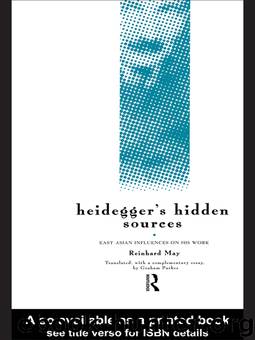Heidegger's Hidden Sources : East-Asian Influences on his Work by May Reinhard

Author:May, Reinhard [May, Reinhard]
Language: eng
Format: epub
Publisher: Taylor and Francis
Published: 2005-10-10T07:00:00+00:00
NOTES
142 Compare the different interpretation of this passage in Cho, Bewusstsein und Natursein, 16 [who takes Heidegger’s assertion of the irrelevance of Zen Buddhism at face value].
143 ‘Briefwechsel mit einem japanischen Kollegen’, 6 [JH, 224].
144 On Heidegger’s view it is precisely this thought that has been misunderstood in the West (see 3.1.1 above, especially the passage [WL 19/US 108–9] cited in note 69).
145 This is how Hsiao seems to have understood Heidegger’s supplement in connection with his original calligraphy of the verse for Heidegger (see HAT 100).
146 Compare the ‘Afterword to “What Is Metaphysics?”’: ‘“Being” (Austrag) as the soundless voice, the voice of stillness [Stimme der Stille]‘ (GA 9:306, footnote f). [The note is appended to the word ‘soundless’ in the context of the possibility of experiencing Being through not shrinking in the face of ‘the soundless voice that summons to the terror of the abyss’ (Wm 102).]
147 The role the Laozi chapter may have played in Heidegger’s ‘Discussion of Gelassenheit’ [‘Conversation on a Country Path about Thinking’], which was published in 1959 but supposedly written in 1944/5, is shown, for example, by a short passage (DT 70/GA 13:51) for which Heidegger drew, presumably before his collaboration with Hsiao, from the version of Laozi 15 by Wilhelm (Laotse, 134) and/or that by von Strauss (LaoTse, 74, 230f). The later versions in the letter to Hsiao would then be simply the expression of new (and deeper) endeavours at appropriation.
148 See section 3 of both ‘The Nature of Language’ and ‘The Way to Language’; the coinage wëgen occurs in the latter essay (WL 129f/US 261f).
149 See ‘What Are Poets For?’, in PLT 99–100/Hw 256; The Thinker as Poet’, in PLT 12/GA 13:84. Compare also Karl Löwith, Denker in dürftiger Zeit (Göttingen 1953, 1965), 11 [where Löwith writes: ‘It is for the most part undecidable whether Heidegger poetizes thinkingly or thinks poetically, so much does he poetically condense a thinking that is associatively disintegrated’].
150 ‘The Anaximander Fragment’, in EGT 5S/Hw 343; compare ‘Logos’, in EGT 78/VA 3: 25.
151 See Walter Biemel, ‘Dichtung und Sprache bei Heidegger’, in Man and World 2/4 (1969):487–514, 490; also his Heidegger (Hamburg 1973), 129.
152 See ‘A Letter to a Young Student’, in PLT 185/VA 2:58 [where Heidegger remarks that he finds it ‘strange’ that people should ask ‘from where [his] thinking receives its directive [Weisung]’].
153 It was not from pre-Socratic thought, nor from Western (theo-)mystical thinking, nor from Nietzsche’s poetic thinking, nor even from Hölderlin’s poetry that Heidegger received the essential impetus for his ‘new’ poetic thinking. One can hardly help but think that the Western thinkers and poets he mentions simply serve to help him further, step by step, his significant [wegweisend] work through so-called dialogue with them, without his attempting or sustaining an authentic interpretation of them.
154 See Hajime Nakamura, Ways of Thinking of Eastern Peoples: India—China—Tibet—Japan (Honolulu 1964,5 1971), 243–6; Joseph Needham, Science and Civilization in China, vol. 2: History of Scientific Thought (Cambridge 1956, 41975), 37.
155 Hsiao instructed Heidegger on this point; see EMH 128.
Download
This site does not store any files on its server. We only index and link to content provided by other sites. Please contact the content providers to delete copyright contents if any and email us, we'll remove relevant links or contents immediately.
| Anthropology | Archaeology |
| Philosophy | Politics & Government |
| Social Sciences | Sociology |
| Women's Studies |
The remains of the day by Kazuo Ishiguro(8763)
Tools of Titans by Timothy Ferriss(8164)
Giovanni's Room by James Baldwin(7125)
The Black Swan by Nassim Nicholas Taleb(6955)
Inner Engineering: A Yogi's Guide to Joy by Sadhguru(6642)
The Way of Zen by Alan W. Watts(6460)
Asking the Right Questions: A Guide to Critical Thinking by M. Neil Browne & Stuart M. Keeley(5584)
The Power of Now: A Guide to Spiritual Enlightenment by Eckhart Tolle(5555)
The Six Wives Of Henry VIII (WOMEN IN HISTORY) by Fraser Antonia(5365)
Astrophysics for People in a Hurry by Neil DeGrasse Tyson(5101)
Housekeeping by Marilynne Robinson(4260)
12 Rules for Life by Jordan B. Peterson(4227)
Double Down (Diary of a Wimpy Kid Book 11) by Jeff Kinney(4153)
The Ethical Slut by Janet W. Hardy(4153)
Skin in the Game by Nassim Nicholas Taleb(4128)
Ikigai by Héctor García & Francesc Miralles(4052)
The Art of Happiness by The Dalai Lama(4016)
Skin in the Game: Hidden Asymmetries in Daily Life by Nassim Nicholas Taleb(3873)
Walking by Henry David Thoreau(3864)
